The AMD Radeon RX Vega 64 & RX Vega 56 Review: Vega Burning Bright
by Ryan Smith & Nate Oh on August 14, 2017 9:00 AM ESTPower, Temperature, & Noise
Moving on from performance metrics, we’ll touch upon power, temperature, and noise. This is also normally where we’d discuss voltages, but as Vega is a new chip on a new architecture, nothing seems to read Vega 64 and 56 correctly.
In terms of average game clockspeeds, neither card maintains its boost specification at 100% with prolonged usage. Vega 64 tends to stay closer to its boost clocks, which is in line with its additional power overhead and higher temperature target over Vega 56.
| Radeon RX Vega Average Clockspeeds | ||
| Radeon RX Vega 64 Air | Radeon RX Vega 56 | |
| Boost Clocks |
1546MHz
|
1471MHz
|
| Max Boost (DPM7) |
1630MHz
|
1590MHz
|
| Battlefield 1 |
1512MHz
|
1337MHz
|
| Ashes: Escalation |
1542MHz
|
1354MHz
|
| DOOM |
1479MHz
|
1334MHz
|
| Ghost Recon: Wildlands |
1547MHz
|
1388MHz
|
| Dawn of War III |
1526MHz
|
1335MHz
|
| Deus Ex: Mankind Divided |
1498MHz
|
1348MHz
|
| GTA V |
1557MHz
|
1404MHz
|
| F1 2016 |
1526MHz
|
1394MHz
|
| FurMark |
1230MHz
HBM2: 868MHz |
1099MHz
HBM2: 773MHz |
With games, the HBM2 clocks ramp up and stay at their highest clock state. Expectedly, the strains of FurMark cause the cards to oscillate memory clocks: between 945MHz and 800MHZ for Vega 64, and between 800MHz and 700MHz for Vega 56. On that note, HBM2 comes with an idle power state (167MHz), an improvement on Fiji's HBM1 single power state. Unfortunately, the direct power savings are a little obscured since, as we will soon see, Vega 10 is a particularly power hungry chip.
As mentioned earlier, we used the default out-of-the-box configuration for power: Balanced, with the corresponding 220W GPU power limit. And under load, Vega needs power badly.
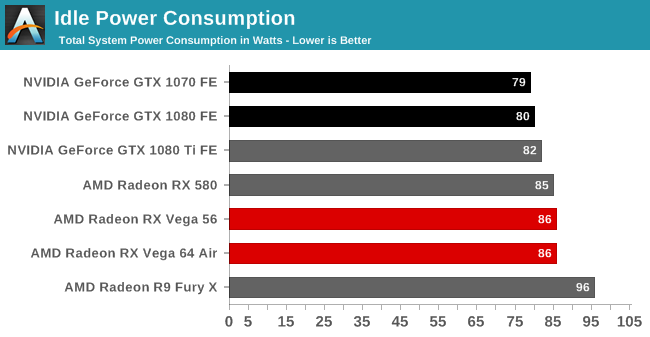
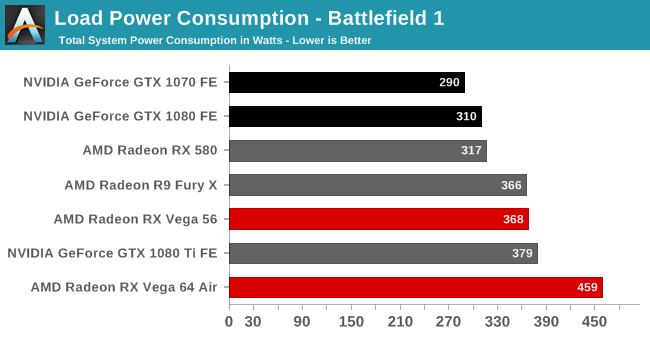
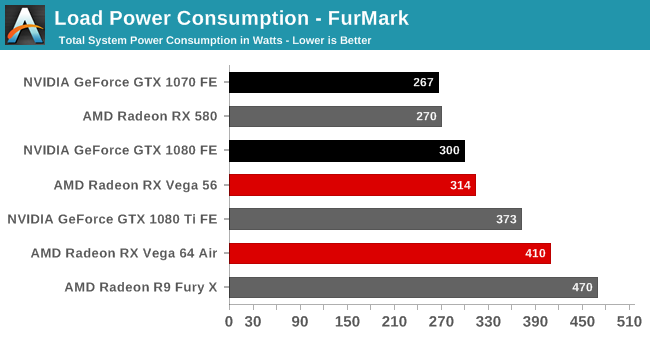
The performance of both Vega cards comes at a significant power cost. For the RX 500 series, we mused that load consumption is where AMD paid the piper. Here, the piper has taken AMD to the cleaners. In Battlefield 1, Vega 64 consumes 150W more system-wide power than the GTX 1080, its direct competitor. To be clear, additional power draw is expected, since Vega 64 is larger in both shader count (4096 vs. 2560) and die size (486mm2 vs. 314mm2) to the GTX 1080. But in that sense, when compared with the 1080 Ti, powered by the 471mm2 GP102, Vega 64 still consumes more power.
As for Vega 64's cut-down sibling, Vega 56's lower temperature target, lower clocks, and lower board power make its consumption look much more reasonable, although it is still well above the 1070.
In any case, the cooling solutions are able to do the job without severe effects on temperature and noise. As far as blowers go, RX Vega 64 and 56 are comparable to the 1080 Ti FE blower.
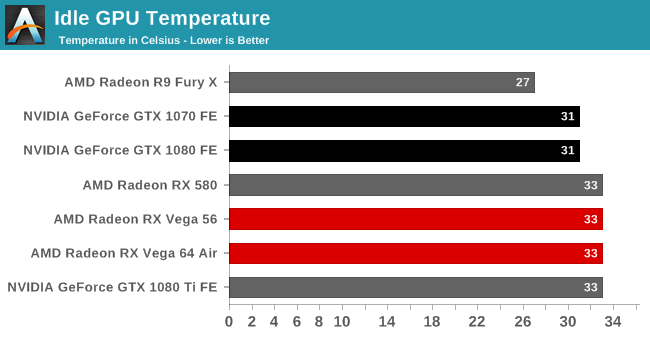
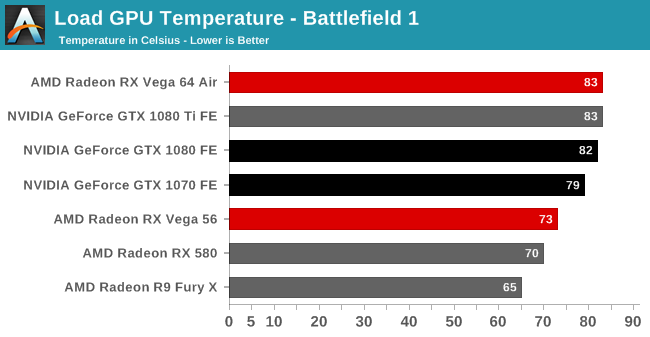

Not Graphed: Temperature of the actual Vega (Star): 9329C
Noise-testing equipment and methodology differ from past results, with a more sensitive noise meter and closer distance to the graphics card. Readings were also taken with an open case. As such, the noise levels may appear higher than expected.

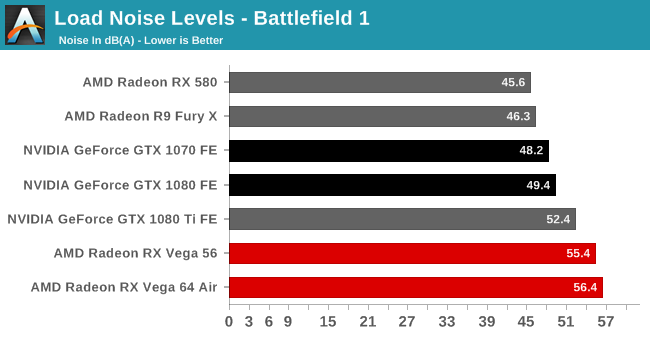
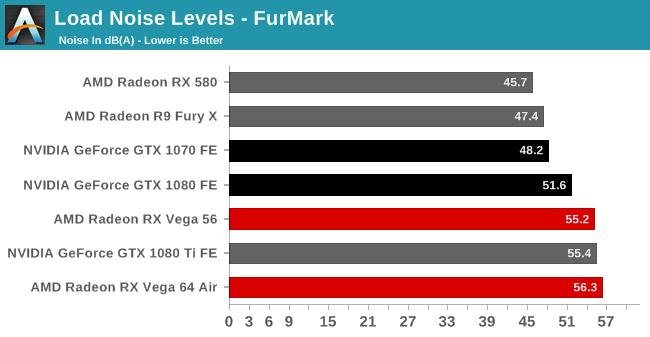










213 Comments
View All Comments
tipoo - Monday, August 14, 2017 - link
For a while those APUs were floating them while their standalone CPUs and GPUs struggled. Maybe they've gotten too slim for three strong tentpoles, alas, and one will always suffer.Da W - Tuesday, August 15, 2017 - link
Buldozer core sucked next to ''ok'' GCN igpu. It was very bandwith dependant and the igpu was most of the time starving for data. There was no point of pushing another dozer apu. They were waiting for Ryzen core, and infinity fabric to feed the gpu. Vega is just launching now and if you noticed AMD is only making one 8 core monolitic die sold in multiple package (1 for ryzen-2 fro treadripper-4 for epic). They have yet to cut that 8 core die in half and integrate their new Vega core in there, which is, i believe, what R&D is doing as of this morning....Yaldabaoth - Monday, August 14, 2017 - link
So, the TL;DR is that the Vega 64 competes on (relatively) cheap computing power and perhaps 4K gaming, and the Vega 56 competes on (relatively) very cheap computing power and being a value for 1440p gaming? Neither seem to compete on efficiency.tipoo - Monday, August 14, 2017 - link
Vega 56 seems well positioned for now. 1070 performance at a decently lower price. Question is if Nvidia can/will drop that price on a whim with enough margin (with a smaller die in theory they could, but AMD is probably getting low margins on these). Vega 64 is a far less clear value prospect, in one way it's similar to the 1070 vs 1080, but with Nvidia you're actually getting the best, which 64 can't claim.Jumangi - Monday, August 14, 2017 - link
Thats the big unknown. I suspect Nvidia is playing with much better margins than AMD is when looking at the chips to compete with them here. If Nvidia can lower prices on the 1070 to squeeze AMD if they want and still make a good profit.webdoctors - Monday, August 14, 2017 - link
The Vega56 is so cheap for the hardware you get I wonder if its being sold for a loss. I commented earlier that I thought these chips would be selling for double what they released at, and if they're profitable at this price point AMD might have some secret low cost manufacturing technology that is worth more than their entire company right now.As a consumer I'm practically getting paid to take it LOL.
tipoo - Monday, August 14, 2017 - link
I doubt it's at a loss, but it's probably at a very slim margin. Nvidia could potentially split the difference with a 50 dollar drop and still have the smaller cheaper die (presumably, if TSMC/Glofo cost similar).Drumsticks - Monday, August 14, 2017 - link
Great review Ryan and Nate. I totally agree with your comment at the end about where Vega was designed. Relative to Nvidia, it's a further step back in almost every metric you can measure - perf/w, perf/mm^2, absolue perf of high end flagship...You really have to hope AMD can find one more rabbit in their hat a year or two from now. Nevertheless, the Vega 56 looks like an impressive product, but you can't be happy about getting 8% more performance out of something >50% larger in silicon.
Morawka - Monday, August 14, 2017 - link
yup and next generation memory to boot.. AMD need better gpu designers. If not for Crypto, AMD would be in serious trouble.Threska - Thursday, April 4, 2019 - link
Hello. I'm writing from the future and I bring important news about Google Stadia." To make it possible on its servers, Google has combined an x86 processor (likely an Intel one) with hyperthreading that runs at 2.7GHz, with 16GB of RAM, and a custom AMD graphics chip. It’s said to uses HBM 2 and has 56 compute units, delivering enough raw horsepower for 10.7 TFlops.
That sounds like a modified Vega 56, although it’s equally possible that it’s one of AMD’s upcoming Navi line of graphics cards."
https://www.digitaltrends.com/gaming/google-stadia...